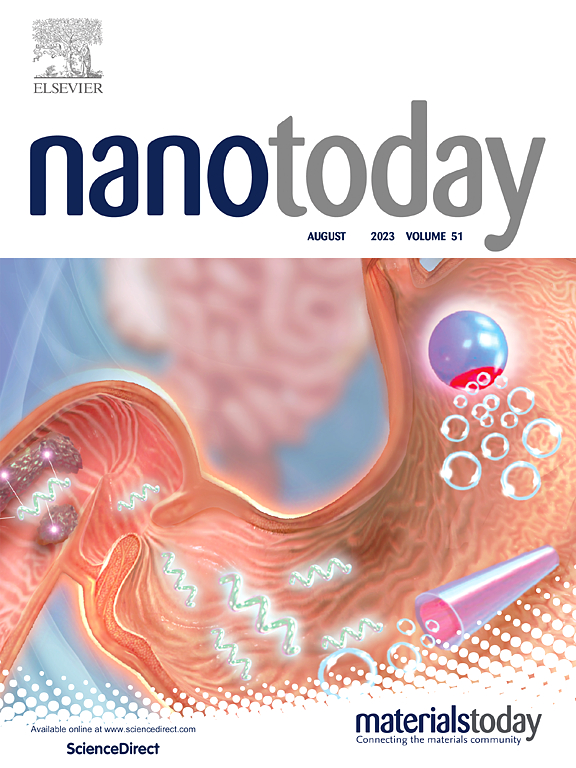葡萄糖门控纳米涂层赋予聚醚醚酮植入物以酶气疗法,促进感染性糖尿病骨整合
IF 13.2
1区 材料科学
Q1 CHEMISTRY, MULTIDISCIPLINARY
引用次数: 0
摘要
糖尿病患者植入物周围的高血糖微环境导致植入失败率和植入物相关感染率居高不下。据报道,一氧化碳(CO)具有抗感染作用;然而,按需释放一氧化碳以及阐明其潜在的抗菌机制仍是一项挑战。为了解决这个问题,我们开发了一种由聚醚醚酮、葡萄糖氧化酶(GOx)和羰基锰纳米晶体(MnCO)组成的多用途骨科植入物,作为一种葡萄糖门控纳米涂层,用于酶促气体疗法,以改善糖尿病感染性骨结合。GOx 可作为葡萄糖触发门对高血糖做出反应,从而在 GOx 驱动的 MnCO 纳米晶体的芬顿反应触发下原位释放二氧化碳。释放出的 CO 可穿透薄膜,与细胞色素 bo3 结合,并在体外干扰呼吸链,从而大大阻止了细菌的繁殖。此外,这种工程植入物还具有理想的抗菌特性,并能增强体内的骨结合。总之,骨科纳米涂层植入物能够提供葡萄糖门控酶气体疗法,有望用于治疗感染性糖尿病骨缺损。本文章由计算机程序翻译,如有差异,请以英文原文为准。
Glucose-gated nanocoating endowing polyetheretherketone implants for enzymatic gas therapy to boost infectious diabetic osseointegration
The hyperglycemic micromilieu surrounding implants in diabetic patients leads to high failure rate of implantation and implant-associated infection. Carbon monoxide (CO) has been reported to combat infections; however, its on-demand liberation and the elucidation of the underlying antibacterial mechanism remain challenging. To address this issue, we develop a multipurpose orthopedic implant comprising polyetheretherketone, glucose oxidase (GOx), and manganese carbonyl nanocrystals (MnCO), serving as a glucose-gated nanocoating for enzymatic gas therapy to improve infectious diabetic osseointegration. The GOx acts as a glucose-actuated gate responsive to hyperglycemia, thereby delivering CO in situ triggered by the GOx-driven Fenton-like reaction of MnCO nanocrystals. The released CO considerably prevents bacterial multiplication by penetrating the membrane, binding to cytochrome bo3, and interfering with the respiratory chain in vitro. Furthermore, the engineered implant displays desired antibacterial properties and enhances osseointegration in vivo. Collectively, the orthopedic nanocoating implant is capable of delivering glucose-gated enzymatic gas therapy, promising for treating infectious diabetic bone defects.
求助全文
通过发布文献求助,成功后即可免费获取论文全文。
去求助
来源期刊

Nano Today
工程技术-材料科学:综合
CiteScore
21.50
自引率
3.40%
发文量
305
审稿时长
40 days
期刊介绍:
Nano Today is a journal dedicated to publishing influential and innovative work in the field of nanoscience and technology. It covers a wide range of subject areas including biomaterials, materials chemistry, materials science, chemistry, bioengineering, biochemistry, genetics and molecular biology, engineering, and nanotechnology. The journal considers articles that inform readers about the latest research, breakthroughs, and topical issues in these fields. It provides comprehensive coverage through a mixture of peer-reviewed articles, research news, and information on key developments. Nano Today is abstracted and indexed in Science Citation Index, Ei Compendex, Embase, Scopus, and INSPEC.
 求助内容:
求助内容: 应助结果提醒方式:
应助结果提醒方式:


